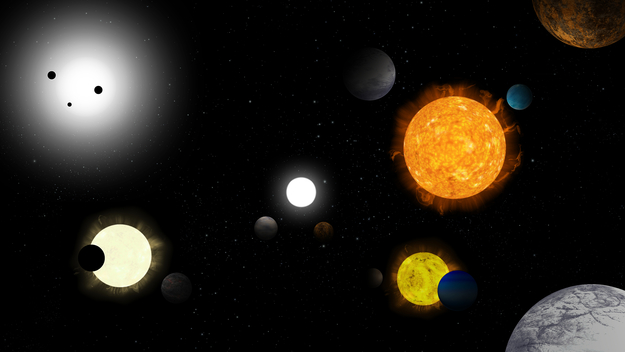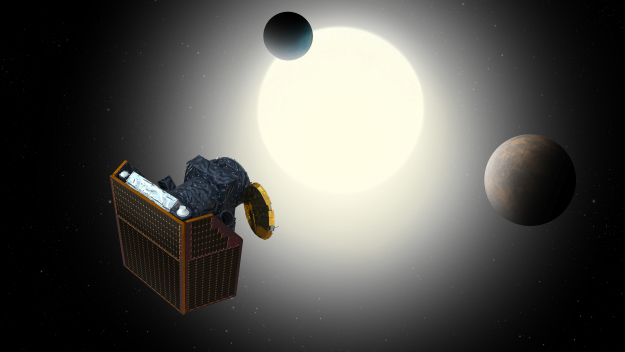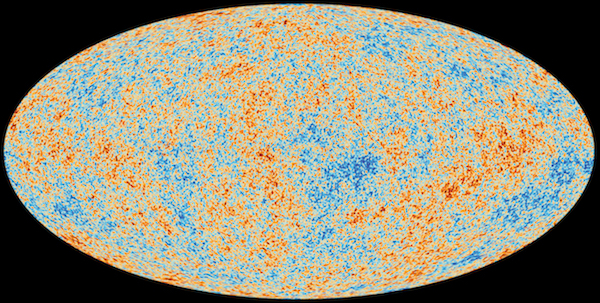Exoplanet and cosmology discoveries awarded Nobel Prize in Physics
8 October 2019
ESA congratulates 2019 Nobel Prize in Physics laureates Michel Mayor and Didier Queloz, who have been awarded the prestigious prize for the first discovery of an exoplanet orbiting a solar-type star, and James Peebles, honoured for the theoretical framework of cosmology used to investigate the Universe on its largest scales. |
| Exoplanet imaginarium. Credit: ESA |
The two halves of this year's award recognise groundbreaking contributions to our understanding of how the Universe formed and evolved, as well as the role of Earth – and of us, as humans – in the overall cosmic picture. Cosmology and exoplanets are among the key themes investigated by ESA's space science missions.
"We are delighted with the Nobel committee's recognition of these two major milestones in astronomy," says Günther Hasinger, ESA Director of Science.
"From the seeds of cosmic structure, generated almost fourteen billion years ago, to the building blocks of planets and even life, the work of Peebles, Mayor and Queloz tackles some of the most profound questions that humanity has ever pondered: where do we come from? Where are we going? Is there life elsewhere in the Universe?
"These fascinating questions inspire and underpin our daily scientific work at ESA, from cosmology missions like Planck and Euclid to our future fleet of exoplanet satellites, including the upcoming CHEOPS mission that will soon characterise many alien worlds."
Exoplanet pioneers
Michel Mayor is an emeritus professor at the University of Geneva, and Didier Queloz is a professor at the University of Geneva and the University of Cambridge.
In the early 1990s, when Queloz was Mayor's PhD student, they were using the Haute-Provence Observatory in southern France to search for subtle changes in the light coming from nearby stars in a quest for signatures of planets beyond the Solar System. These pioneering observations eventually revealed 51 Pegasi b, the first exoplanet found around a star like our Sun.
Announced just 24 years ago this month during an astronomy conference in Florence, the discovery of Mayor and Queloz has forever changed our perspective on the cosmos. Revealing a planet that was unlike anything seen in our Solar System, the finding shook our theoretical understanding of planetary formation and inaugurated a flurry of investigations in the burgeoning field of exoplanets.
 |
| CHEOPS satellite. Credit: ESA/ATG medialab |
In the past quarter of a century, astronomers have been exploiting observatories on ground and in space and discovered more than 4000 exoplanets. The next endeavour in this exciting subject is ESA's Characterising Exoplanet Satellite, CHEOPS, which is currently undergoing final preparations ahead of its launch scheduled for mid December.
Once in space, CHEOPS will perform detailed observations of bright stars known to host planets, particularly in the Earth-to-Neptune size range, enabling a first step towards characterising the nature of these distant, exotic worlds. Didier Queloz is the Chair of the CHEOPS Science Team, which comprises experts from eleven ESA member states.
In the next decade, ESA is planning two more missions dedicated to the study of exoplanets – PLATO, the PLAnetary Transits and Oscillations of stars mission, and ARIEL, the Atmospheric Remote-sensing Infrared Exoplanet Large-survey mission – keeping European science at the forefront of exoplanet research.
From planets to the cosmos
James Peebles, Albert Einstein Professor of Science Emeritus at Princeton University, started developing theoretical models that lay the foundation of our understanding of the Universe's formation and evolution in the 1960s, greatly contributing to the impressive growth of modern cosmology.
 |
| Planck's view of the CMB. Credit: ESA and the Planck Collaboration |
The theoretical framework put forward by Peebles describes the evolution of the large-scale structure we see in today's Universe based on the seeds that are observed in the Cosmic Microwave Background (CMB), the most ancient light in cosmic history, released when the Universe was only 380 000 years old. ESA's Planck mission, operating between 2009 and 2013, has obtained the most precise picture of the CMB, enabling investigations that have confirmed this view of the Universe to unprecedented accuracy.
But not all mysteries are solved. In the 1980s, Peebles' intuitions were also key to recognise two major missing ingredients in the leading cosmological model – dark matter and dark energy. Another ESA mission, Euclid, currently in preparation and due to launch in 2022, will observe billions of galaxies to probe the past ten billion years of the Universe's expansion and shed light on these two mysterious cosmic components.
For further information, please contact:
ESA Newsroom and Media Relations
Email: media![]() esa.int
esa.int



